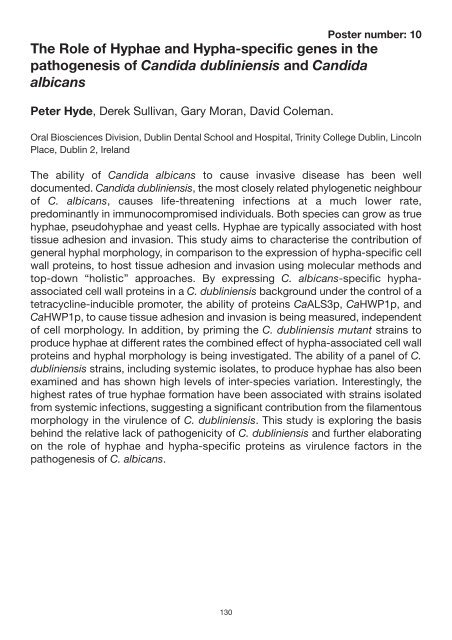Candida Infection Biology – fungal armoury, battlefields ... - FINSysB
Candida Infection Biology – fungal armoury, battlefields ... - FINSysB
Candida Infection Biology – fungal armoury, battlefields ... - FINSysB
You also want an ePaper? Increase the reach of your titles
YUMPU automatically turns print PDFs into web optimized ePapers that Google loves.
Poster number: 10<br />
The Role of Hyphae and Hypha-specific genes in the<br />
pathogenesis of <strong>Candida</strong> dubliniensis and <strong>Candida</strong><br />
albicans<br />
Peter Hyde, Derek Sullivan, Gary Moran, David Coleman.<br />
Oral Biosciences Division, Dublin Dental School and Hospital, Trinity College Dublin, Lincoln<br />
Place, Dublin 2, Ireland<br />
The ability of <strong>Candida</strong> albicans to cause invasive disease has been well<br />
documented. <strong>Candida</strong> dubliniensis, the most closely related phylogenetic neighbour<br />
of C. albicans, causes life-threatening infections at a much lower rate,<br />
predominantly in immunocompromised individuals. Both species can grow as true<br />
hyphae, pseudohyphae and yeast cells. Hyphae are typically associated with host<br />
tissue adhesion and invasion. This study aims to characterise the contribution of<br />
general hyphal morphology, in comparison to the expression of hypha-specific cell<br />
wall proteins, to host tissue adhesion and invasion using molecular methods and<br />
top-down “holistic” approaches. By expressing C. albicans-specific hyphaassociated<br />
cell wall proteins in a C. dubliniensis background under the control of a<br />
tetracycline-inducible promoter, the ability of proteins CaALS3p, CaHWP1p, and<br />
CaHWP1p, to cause tissue adhesion and invasion is being measured, independent<br />
of cell morphology. In addition, by priming the C. dubliniensis mutant strains to<br />
produce hyphae at different rates the combined effect of hypha-associated cell wall<br />
proteins and hyphal morphology is being investigated. The ability of a panel of C.<br />
dubliniensis strains, including systemic isolates, to produce hyphae has also been<br />
examined and has shown high levels of inter-species variation. Interestingly, the<br />
highest rates of true hyphae formation have been associated with strains isolated<br />
from systemic infections, suggesting a significant contribution from the filamentous<br />
morphology in the virulence of C. dubliniensis. This study is exploring the basis<br />
behind the relative lack of pathogenicity of C. dubliniensis and further elaborating<br />
on the role of hyphae and hypha-specific proteins as virulence factors in the<br />
pathogenesis of C. albicans.<br />
130


